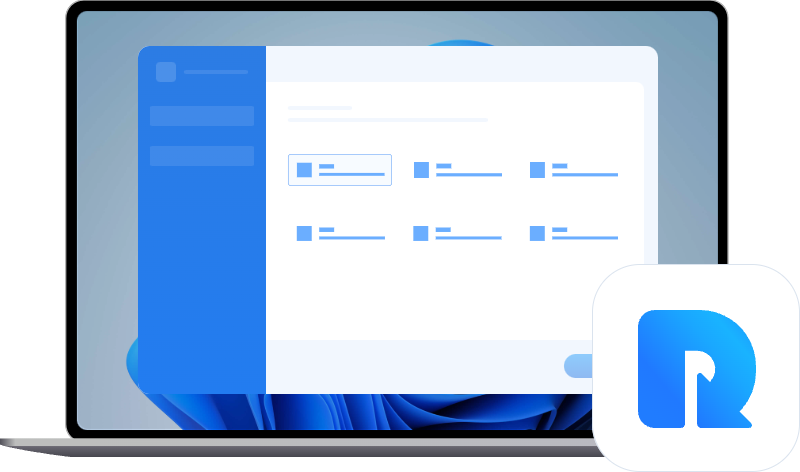FREE Download SanDisk SSD Data Recovery Software (2024)
Want to know SanDisk SSD data recovery? The most effective method is using data recovery software like MyRecover. Continue to read this article and learn how to use it.
SanDisk SSD (Solid State Drives) are known for their speed and reliability and work just like hard drives to store data on your computer. During use you may encounter issues such as SanDisk SSD is not accessible or SanDisk SSD not showing up.
Don’t panic, in this article, we will let you know how to get back data from SanDisk SSD easily and solutions to the common issues you may encounter while using SanDisk SSD.
Causes for SanDisk SSD Data Loss
SanDisk SSD like any storage device, can still experience data loss due to various factors. Here are some common causes of data loss on SanDisk SSD:
- Accidental Deletion or Formatting. Human error, such as accidentally deleting files or formatting the SSD, is a common cause of data loss.
- File System Conversion. Changing the file system on the SSD or attempting to convert it can lead to data loss if not done correctly.
- Virus Infection. Malicious software can corrupt files or make them inaccessible, resulting in data loss.
- Physical Damage. Such as dropping it or exposing it to extreme temperatures or moisture, can render it unreadable and result in data loss.
- Bad Sectors. The emergence of bad sectors on the SanDisk SSD, which are damaged portions of the storage, can render data stored in those sectors unreadable.
- Firmware Bug. Firmware bugs also often appear in SanDisk Extreme SSD and SanDisk Extreme Pro SSD, leading to data loss.
How to Perform SanDisk SSD Data Recovery Effectively (2 Ways)
Way 1. Recover Deleted Files from SanDisk SSD with MyRecover
The easiest and most effective way is to use the powerful data recovery software MyRecover to perform SanDisk Ultra, Extreme, Extreme Portable, SSD Plus, etc. SSD data recovery. With its advanced algorithms, you are able to find all the deleted or lost files on SanDisk SSD easily, with a high success rate.
🍕 Recover 200+ formats: It is able to recover deleted Microsoft Word, Excel, PPT, PDF, PPTX, JPG, PNG, MP4, MOV, MP3, CDA, 7Z, ZIP, MSG, EML, and more.
🍕 Quick & Deep scancanquickly and thoroughly locate all recoverable datafrom SanDisk SSD.
🍕 Various data recovery scenarios: accidental deletion, unintentional formatting, file system conversion, bad sectors, firmware bugs, virus infection, etc.
🍕 Enabling file filtering and preview by Files Type, Size, Date, etc to locate your wanted files quickly.
🍕 Excellent compatibility: Support all the file systems: NTFS/FAT/exFAT/ReFS in Windows 11/10/8/7 & Windows Server.
Steps to perform SanDisk SSD data recovery
Step 1. Download and run MyRecover on your Windows. ( This free version supports you recover SanDisk SSD for free, up to 500MB) Connect the SanDisk SSD to the PC and select it. Hover the mouse over the SanDisk SSD saved deleted files before, and click Scan.
Step 2. MyRecover will scan your SanDisk SSD automatically and thoroughly to locate all the found data on the select drive. You can use the Search Box or the Filter feature to quickly locate the files you want.
- Type: Select the file type (Documents, Images, Videos, Audios, Mails, Webpages, Compressed files, etc.)
- Date modified: Set the date (today, yesterday, last 7/30 days, etc.)
- Size: Filter the file size (<128KB, 128KB~1MB, 1MB~ 512MB, 512MB above, etc.)
Step 3. You will see a list of data that MyRecover found on your SanDisk SSD. Choose your desired files to recover and press Recover x files.
Step 4. Select a new location to save the recovered files and click Select Folder to confirm it. Your files will be recovered in a few minutes or longer, depending on the amount of data you want to recover.
Congratulations. You have successfully completed SanDisk SSD data recovery.
- You can do data recovery from SanDisk SSD for free, up to 500MB. Once exceeded, please upgrade to the advanced editions.
- If you are unable to recover SanDisk SSD data with software or the situation is complicated, it's wise to seek help from data recovery services such as Geek Squad. They have skilled professionals and advanced equipment to handle even the toughest data recovery cases.
Way 2. Recover Deleted Files Using SanDisk RescuePRO
SanDisk RescuePRO is a specialized recovery software designed for SanDisk storage devices. This tool supports a wide range of file types, including photos, videos, documents, and music files. Unlike MyRecover, SanDisk RescuePRO does not support file previews, the free version does not support certain RAW image formats, and it takes a long time to reindex the drive.
Here’s how to perform SanDisk SSD data recovery using SanDisk RescuePRO:
Step 1. Go to the official website to download and install SanDisk RescuePRO. Launch the software and and click Recover All Files.
Step 2. Select your SanDisk SSD from the list and click Start.
Step 3. The software will start scanning your device. You can select an Out put Folder to save the recovered files. After the scan is complete, all files will be automatically saved in this folder.
If SanDisk RescuePRO cannot recover your data, please go to Way 1 and use the powerful data recovery software - MyRecover to easily recover your data.
Practical Solutions for Common SanDisk SSD Issues
SanDisk SSDs may encounter various common problems, but there are practical solutions available to address these issues. In this section, we will provide solutions for these prevalent SanDisk SSD errors.
Issue 1: Write Protection on SanDisk SSD
If you receive a message indicating that your SanDisk SSD is write-protected, you'll be unable to add, delete, or transfer data to the drive. To resolve this, follow these steps:
1. Start your Windows computer and click the "Start". Type "CMD" and press Enter.
2. A new window will open; type "diskpart" and press Enter;
3. Again type "list disk" and press Enter.
4. To select your write-protected SanDisk SSD drive, type "select disk *" (replace * with the drive's number) and press Enter.
5. Finally, type "attributes disk clear readonly" and press Enter to remove the write protection from your SanDisk SSD.
Issue 2: SanDisk SSD Not Recognized by Your Computer
Sometimes your SanDisk SSD drive is not recognized by the computer. You need to perform a SanDisk SSD drive repair. Here is how you can do it.
1. Verify for any loose connections or cable issues.
2. Ensure your PC has a sufficient power supply and is functioning correctly.
3. Test the SSD again to ensure that the issue has been resolved.
4. Try another USB port on your PC; sometimes, they might not work well.
5. Attempt to connect your device to another computer or laptop; compatibility issues may arise at times.
Issue 3: Frequent SSD Drive Formatting Requests
When your SSD drive consistently prompts you to format it, there may be an underlying issue with the drive. Opt to format the drive to resolve this problem. If you have crucial data on the drive, utilize SanDisk SSD recovery software MyRecover to retrieve your lost data first. Then follow the steps below to format the SanDisk SSD.
1. Right-click the Start menu and choose "Disk Management" Connect your SSD to the computer
2. In Disk Management, find your SSD drive and right-click it; select "Format"
3. Choose the file system you want (typically NTFS for Windows).
4. Click "OK" or "Format" to start the process. Wait for the formatting to complete.
Issue 4: Inaccessible Files Becoming Thumbnails
If you find that the files within your SanDisk SSD have become inaccessible and appear only as thumbnails, a virus or malware attack is a likely culprit. To protect both your SanDisk SSD and computer, follow the formatting instructions above to format your SSD drive. Likewise, if you don’t want to lose data, use recovery software MyRecover in the same way to recover valuable data from SanDisk SSD first.
7 Tips: How to Avoid Data Loss on SanDisk SSD
Losing data can be a nightmare, especially when it happens to a reliable storage device like your SanDisk SSD. To avoid this, here are some practical steps you can follow:
1️⃣ Back up regularly: One of the best ways to prevent data loss is to back up your data regularly. Use a cloud storage service or an external hard drive to back up important files weekly. Here is a free backup software for Windows - AOMEI Backupper Standard you can try.
2️⃣Use trusted card readers and adapters: When using your SanDisk SSD with card readers or adapters, make sure they are reliable and of good quality. A faulty card reader or adapter can corrupt your data and damage your SSD.
3️⃣ Keep your system virus-free: Run antivirus scans regularly on your computer. Malware and viruses can corrupt your data and make your files inaccessible. Use a trusted antivirus software to keep your system safe.
4️⃣ Update firmware and software: Make sure your SSD firmware and system software are up to date. Manufacturers frequently release updates to improve performance and security.
5️⃣ Avoid Overloading Your SSD: Try not to fill your SSD to its maximum capacity. Leave some space to ensure optimal performance and reduce the risk of data corruption.
6️⃣ Use Reliable Data Recovery Software: If you accidentally lose data, use reliable data recovery software. Some tools may cause further data corruption. MyRecover is a trustworthy option that can help you recover data from SSD efficiently.
7️⃣ Prevent physical damage: Handle your SanDisk SSD carefully. Avoid dropping it or exposing it to extreme temperatures. Physical damage can lead to data loss and shorten the life of your SSD.
Conclusion
You now have the knowledge of SanDisk SSD data recovery using the data recovery software MyRecover and SanDisk RescuePRO. One of the highly recommended solutions is MyRecover, a reliable data recovery software known for its user-friendliness and powerful features. You can also easily recover deleted files from external hard drives, SD cards, USB flash drives, SSD, HDD, and other storage devices. Download MyRecover now to enjoy it! Download the tool for free and enjoy its convenience!
Remember, it's crucial to regularly back up your data and rely on a dependable storage device to minimize the risk of losing your SanDisk SSD data. When a crisis strikes, you'll be able to restore files from backups quickly and get your files back.


